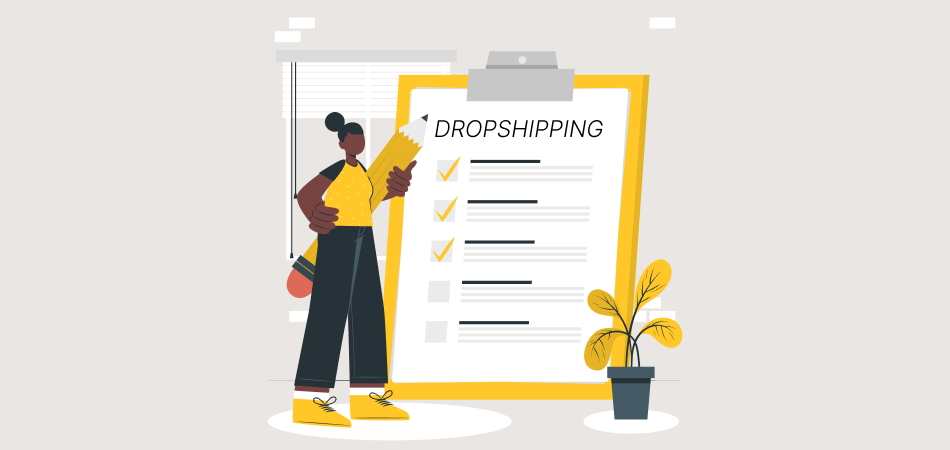How to Achieve Dropshipping Success: Your Must-Have Steps Checklist

The dropshipping market is nearly expected to reach $301.11 billion in 2024, $372.47 billion in 2025, and maybe $476.1 billion by 2026. That being said, dropshipping success is a gradual process. Thorough planning, strategic implementation, and ongoing adjustment to market developments are necessary. We'll explore the essential actions required to succeed with dropshipping in this article, stressing the value of having an extensive dropshipping checklist.
Why Does Preparing a Checklist Matter
In the fast-paced world of dropshipping, where several jobs must be handled at once, the value of having a well-thought-out checklist cannot be emphasized. This is why it's important to have a thorough dropshipping checklist:
Organization and Structure
A checklist outlines all the necessary stages and duties that must be accomplished, giving your dropshipping business a well-organized foundation. A checklist helps you avoid mistakes and makes sure nothing gets missed by breaking down your workflow into manageable tasks.
Efficiency and Productivity
You may improve your efficiency and optimize your process by having a checklist on hand. A checklist helps you prioritize work, manage resources wisely, and concentrate on high-impact areas by dissecting intricate processes into smaller, simpler tasks.
Consistency and Quality Control
The secret to success in dropshipping is consistency. A checklist acts as a point of reference to make sure that standard operating procedures are adhered to consistently in all areas of your company, including marketing, customer support, order fulfillment, and product procurement. This consistency maintains quality standards, fosters consumer trust, and improves operational efficiency.
What Are the Must-Have Steps for the Checklist
To streamline your dropshipping endeavors and maximize your chances of success, let's break down the must-have steps for your dropshipping checklist:
1. Niche Research & Selection
Niche Market Research
Conduct thorough markt research to identify lucrative niche markets with high demand and low competition. Understanding your target audience's needs and preferences is crucial for selecting profitable product categories.

Competitors Analysis
Analyze your competitors' strategies, pricing, and product offerings to identify gaps and opportunities within your niche. This insight will inform your own competitive strategy and help you differentiate your brand in the market.
Suppliers Selection
Partner with reputable and renowned suppliers who offer super-quality products, reliable shipping, and excellent customer service. Establishing strong relationships with reliable suppliers is essential for maintaining product quality and ensuring timely order fulfillment.

|
Find Better Supplier For Products DSers Supplier Optimizer - One click to filter out the most proper suppliers for your products |
Pricing Strategy
Develop a competitive pricing strategy that accounts for product costs, shipping fees, and desired profit margins. Striking the right balance between competitiveness and profitability is key to attracting customers while maximizing your revenue.
2. Dropshipping Business Setting Up
Important actions must be taken to set up your dropshipping business and ensure its success. Below is a breakdown of the crucial steps that need to be taken:
Dropshipping Platform
Select a user-friendly e-commerce platform that aligns with your business needs and budget. Platforms like Shopify, WooCommerce, and Wix offer robust features tailored to dropshipping businesses.

Dropshipping Store
Customize your online store to reflect your brand identity and showcase your products effectively. Invest in high-quality imagery, compelling product descriptions, and intuitive navigation to enhance the customer shopping experience.
Dropshipping Tools
Utilize dropshipping tools and software to streamline order management, inventory tracking, and supplier selection. Integration with apps like DSers can simplify the process of sourcing and fulfilling products.
Dropshipping Payment
Ensure secure payment processing by integrating a reliable payment gateway that encrypts sensitive customer data and facilitates seamless transactions. Popular options there are, such as PayPal, Stripe, and Shopify Payments.
3. Product Management
A successful dropshipping business depends on careful product selection and management, which guarantee that you provide high-quality products and keep your inventory levels under control.
Ensure Quality and Reliability
Prioritize product quality and reliability to build trust and credibility with your customers. Thoroughly vet suppliers and products to ensure consistency in quality and customer satisfaction.
Implement Efficient Product Management Systems
Streamline product management processes by organizing products into categories, optimizing product listings, and regularly updating inventory and pricing information. This ensures accuracy and consistency across your online store.
Maintain Adequate Inventory Levels
Monitor inventory levels closely and maintain sufficient stock to fulfill customer orders promptly. Implement inventory management systems to track stock levels and automate reorder processes as needed.
4. Marketing and Promotion
In the competitive dropshipping marketplace, sales and customer acquisition depend heavily on efficient marketing and promotion. The following are essential tactics to raise brand awareness and interest in your target market:
Develop Brand Identity
Build a strong brand identity that resonates with your target audience and sets you apart from competitors. Define your brand's unique value proposition, visual elements, and brand messaging to establish a memorable brand presence.
Utilize SEO Techniques
Optimize your online store for search engines by incorporating relevant keywords, meta tags, and optimized content. Implement on-page and off-page SEO strategies to improve visibility and drive organic traffic to your store.
Create Compelling Product Descriptions
Craft persuasive product descriptions that highlight key features, benefits, and value propositions. Use persuasive language, storytelling, and customer reviews to engage and entice potential buyers.
Implement Email Marketing Campaigns
Build and nurture relationships with your customers through targeted email marketing campaigns. Send personalized promotions, product recommendations, and exclusive offers to encourage repeat purchases and foster customer loyalty.
5. Customer Support
Maintaining a successful dropshipping business requires providing excellent customer service and retention. Here's how to guarantee top-notch customer service and cultivate enduring relationships with your clients:
Timely Customer Support
Prioritize excellent customer service by promptly addressing inquiries, resolving issues, and providing assistance throughout the purchase journey. Invest in responsive customer support channels such as live chat, email, and phone support to ensure a positive customer experience.

Hassle-Free Returns and Refunds
Establish clear and transparent return and refund policies to instill confidence and trust in your customers. Make the returns process seamless and hassle-free to encourage repeat purchases and enhance customer satisfaction.
Loyalty Programs
Reward loyal customers with incentives, discounts, and exclusive perks through loyalty programs. Encourage repeat purchases and foster long-term relationships by offering rewards for referrals, purchases, and engagement.
6. Monitoring and Optimization
During the critical stage of "Monitoring and Optimization," companies need to monitor performance indicators carefully and adjust their plans to ensure long-term success. Here's how to keep an eye on and improve your dropshipping business:
Track Sales Performance
Monitor Key Performance Indicators (KPIs) such as sales revenue, conversion rates, and average order value to gauge the effectiveness of your dropshipping efforts. Identify trends, patterns, and areas for improvement to optimize your strategies accordingly.
Analyze Key Metrics
Analyze customer data, website analytics, and sales metrics to gain insights into customer behavior and preferences. Use this data to refine your product offerings, marketing strategies, and customer experience to drive growth and profitability.
Optimize Product Listings
Continuously optimize product listings by A/B testing titles, descriptions, images, and pricing to maximize conversions and sales. Incorporate customer feedback and performance data to refine product offerings and enhance product visibility.
Adapt Marketing Strategies
Stay agile and adapt your marketing strategies based on evolving market trends, consumer preferences, and competitive landscape. Experiment with new channels, tactics, and messaging to stay relevant and engage your target audience effectively.
7. Legal and Compliance Considerations
To guarantee regulatory compliance and preserve customer trust, legal and compliance considerations are essential components of operating a dropshipping business. Following are some main points you should know:
Register Your Business
Register your dropshipping business as a legal entity and obtain any necessary licenses or permits to operate legally in your jurisdiction. Consult with legal professionals to ensure compliance with local regulations and tax requirements.
Comply with Tax Regulations
Familiarize yourself with tax regulations and obligations related to e-commerce and dropshipping. Collect and remit sales tax as required by law and maintain accurate financial records to facilitate tax filing and compliance.
Ensure Data Privacy and Security
Prioritize data privacy and security by implementing robust cybersecurity measures and compliance with data protection regulations such as GDPR or CCPA. Safeguard customer data and sensitive information to build trust and maintain credibility with your customers.
8. Continuous Learning and Adaptation
Continuous learning and adaptation are essential elements for success in the dynamic and evolving dropshipping industry. By keeping abreast of industry developments and cultivating an innovative culture, enterprises may maintain a competitive edge and optimize their expansion prospects.
Stay Updated with Industry Trends
Keep abreast of industry trends, market dynamics, and emerging technologies in the e-commerce and dropshipping space. Subscribe to industry publications, attend conferences, and participate in online forums to stay informed and adapt your strategies accordingly.
Seek Feedback and Reviews
Solicit feedback from customers to gain valuable insights into their experiences, preferences, and pain points. Encourage customers to leave reviews and testimonials to build social proof and credibility for your brand.

|
Manage Multiple Stores In One Account Multiple Stores Management - Link and manage multiple stores on different platforms in one place |
Embrace Continuous Improvement
Foster a mindset of continuous improvement and learning within your organization. Analyze successes and failures, learn from past experiences, and iterate on your strategies to drive sustainable growth and long-term success.
Conclusion
Achieving success in dropshipping requires a strategic approach, meticulous planning, and relentless execution. By following the comprehensive dropshipping checklist outlined in this guide, you can streamline your operations, attract customers, and build a thriving e-commerce business.












 Company
Company
 Why Choose DSers
Why Choose DSers
 Blog
Blog
 Help Center
Help Center




 Live Chat
Live Chat